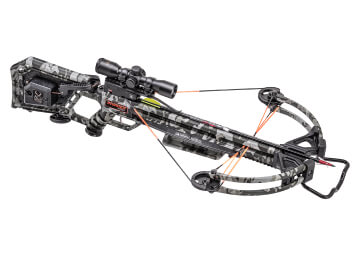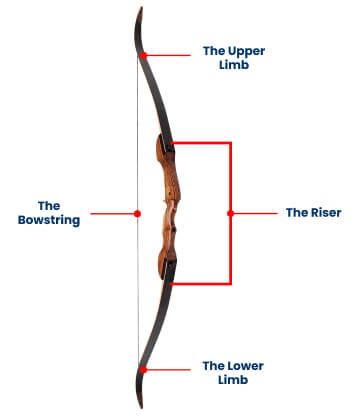9 Different Types of Bows for Hunting + Archery
Picture yourself aligning your bow with the target — your focus narrows as you draw the string back and feel the anticipation of watching the arrow soar through the air! Archery (from hunting to competition to recreation) has evolved into a cultural mainstay. The type of bow you choose can significantly shape your experience.
So many bow types are available. Each boasts distinct characteristics, draw weights, and applications. It’s no wonder it can be hard to find the perfect one. Whether you're an experienced archer or a complete novice eager to learn, this guide will help you navigate the diverse world of bows and archery.
Key Takeaways
- Discover the most popular types of bows. Get a quick snapshot of how to use each, their different draw weights, prices, & more!
- Deepen your understanding of different bow types you'll most often see in stores: the recurve, compound, longbow, and hunting crossbow.
- Learn all about other types of bows that have specific use cases or strong cultural roots: the barebow, flatbow, shortbow, and more.
- Understand the general parts of a bow: from the riser to the bowstring and more.
- Discover the different types of archery — from target archery to 3D.
Different Types of Bows
Bows are far from a one-size-fits-all tool. They vary in categories, methods, draw weights, prices, and more. Discover the most popular types of bows available on the market today:
| 4 Most Popular Types of Bows | |||||
|---|---|---|---|---|---|
| Type of Bow | How to Use | Draw Weight | Best Uses | Good For | Price |
| Recurve Bow | Hold the bow in one hand, draw the string back with the other, aim, and release | Varies, often between 15-60 lbs | Target shooting, hunting, Olympics | Beginners to intermediate archers, those interested in traditional archery | $50 - $500 |
| Compound Bow | Similar to recurve, but with a mechanical system that reduces the draw weight when fully drawn | Varies, often between 40-70 lbs | Hunting, target shooting, competitions | Intermediate to advanced archers, hunters | $200 - $1500 |
| Longbow | Similar to recurve, but requires a longer draw | Varies, often between 30-60 lbs | Target shooting, historical reenactments | Those interested in traditional archery, history enthusiasts | $100 - $800 |
| Hunting Crossbow | Load the bolt, draw the string back with a crank or lever, aim using a sight, and release with a trigger | Varies, often between 75-200 lbs | Hunting, target shooting | Those with less physical strength, hunters | $200 - $2000 |
Types of Bows
Explore an in-depth analysis of the four most common types of bows available today — often seen in popular movie franchises and action films. Familiarize yourself with your local crossbow regulations so you stay compliant with your local and state laws.
Recurve Bow

The recurve bow (one of the oldest types of bows) has a distinct shape. The upper and lower limbs curve away from the archer. This design not only gives it a unique aesthetic but also provides several advantages:
-
More powerful than a straight-limb bow due to the curve of the limbs
-
Constructed from a variety of materials — including carbon, fiberglass, and wood
-
Suitable for both beginners and more advanced archers due to its versatility
-
Capable of reaching impressive speeds of up to 124 mph
-
Typically made with laminated carbon fiber and carbon foam in the limbs and aluminum or carbon fiber in the riser (handle)
Expert Tip:
Avoid dry firing your bow! Dry firing simply means releasing the string without an arrow. Doing so can cause significant damage (e.g. splintering limbs or snapping a string). The debris could potentially injure someone nearby.
Compound Bow

The compound bow is a modern innovation in archery that was first introduced in the 1970s. It's distinguished by its system of pulleys, cams, and cables that all work together to provide the archer with mechanical advantage and precision.
-
The unique system allows the archer to pull back more weight and have more time to aim
-
Typically constructed from composite materials that offer durability and performance advantages over traditional wood
-
Can be equipped with archery sights and release aids to further improve accuracy
-
Frequently used for hunting wild game due to its power and precision
-
The frame is usually made from aluminum or carbon fiber, while the limbs are typically constructed from fiberglass
Longbow

The longbow, characterized by its simple design of a long pole with a string, is a classic in the world of archery. Bow types like the longbow have distinct characteristics, including:
-
Known for its difficulty to master — presenting a rewarding challenge for archers
-
The draw weight of the bow increases proportionally with its length
-
Versatile in its use and suitable for both hunting and target shooting
-
Traditionally made from wood or bamboo, which both give it a natural and authentic feel
Hunting Crossbow

The hunting crossbow has a trigger-release mechanism that offers a user-friendly introduction to the world of archery.
-
Considered the easiest to use among all types of bows due to its point and aim function
-
Ideal for beginners or individuals with disabilities due to its ease of use
-
Features a higher draw weight that is typically operated using a crank mechanism, which helps add significant power for hunting
Other Types of Bows
If you're hesitant to explore the more popular types of bows, consider learning about other varieties. Some are more beginner-friendly, while others cater to advanced archers or originate in cultural traditions.
Barebow

The barebow (a stripped-down version of the recurve bow) offers a pure and unadulterated archery experience:
-
Lacks additional sights or accessories — providing a raw and traditional archery experience
-
Commonly used in field archery and target archery due to its simplicity
-
The archer draws the string toward their face and uses the length of the arrow as a guide for aiming
Shortbow
The shortbow (historically used as a military weapon) offers a compact and versatile archery experience:
-
Despite its shorter length, it can take the form of a D-shaped longbow or a recurve bow
-
Offers less power, making it better suited for shorter ranges
-
Its shot uses your hands as an arrow rest and eliminates the need for left or right-handed variants
Flatbow
Bow types like the flatbow offer a versatile, user-friendly option — remaining a favorite among amateur marksmen:
-
Can be either long or short, offering flexibility in its design
-
Traditionally made from wood, which provides a natural feel
-
Features a narrow grip in the center for more comfortable handling
Reflex Bow
The reflex bow (characterized by its distinctive curves at the ends) offers a powerful archery experience:
-
Resembles a recurve bow but with more pronounced curves at the ends
-
The recurve version of the reflex bow is typically stronger
-
The limbs form a 'C' shape, providing increased power for each shot
Kyudo Bow (Yumi)

The Kyudo Bow (also known as the Yumi) is a unique and traditional piece in Japanese archery:
-
Noticeably asymmetrical with the top limb being longer and more curved than the bottom limb
-
Used in the traditional Japanese archery practice known as Kyudo
-
The grip is positioned a third of the way up — adding to its distinctive design
-
Crafted from a variety of materials (including wood, leather, and bamboo), which reflect its rich cultural heritage
What Are the General Parts of a Bow?

All bows consist of three main components: the limbs, the riser, and the bowstring. Together, these three parts work together to make every shot possible.
-
Limbs: Find both limbs attached to the top and bottom of the riser. They hold the bowstring at both string nocks. As you draw and release the string, they flex — transferring energy to the bow and propelling the arrow forward.
-
Riser: Locate the riser at the center of the bow to grip the bow. You’ll find two types of risers: left-handed and right-handed.
-
Bowstring: Find the string running up and down between both riser ends. This piece holds the arrow in place until you release the arrow and take your shot.
Types of Archery

There’s nothing quite like the adrenaline rush you get when your arrow hits the center bullseye! Keep reading for an overview of the different types of archery.
Target Archery
Target Archery (a popular form of the sport) involves shooting at multi-colored, circular targets:
-
The targets feature yellow, red, blue, black, and white rings — each awarding different points
-
Distances vary based on the type of bow: 70 meters for recurve archers & 50 meters for compound archers
Expert Tip:
Barebow and longbow archers typically shoot between 50-70 meters (though distances for men using longbows can extend up to 90 meters).
3D Archery
3D Archery offers a dynamic and interactive shooting experience:
-
Involves shooting at stationary foam animal targets set up on a course
-
Typically, 1-3 arrows are shot at each animal target
-
Each target features rings that yield different point values when a marksman strikes them, adding a competitive element to the activity
Adaptive Archery
Adaptive archery provides an inclusive platform for people with impairments:
-
Designed for disabled persons (including those who use wheelchairs)
-
The Para archery discipline caters specifically to athletes with a visual or physical impairment
-
Assistive devices (like mouth tabs) enable people with disabilities to participate fully in the sport
Have Fun Out There!
Eager to master the art of archery? Start by exploring our extensive range of different types of bows and arrows. We offer different bow types — each designed to cater to your unique needs. Begin your archery journey with us, and you’ll be shooting arrows like a pro in no time!


